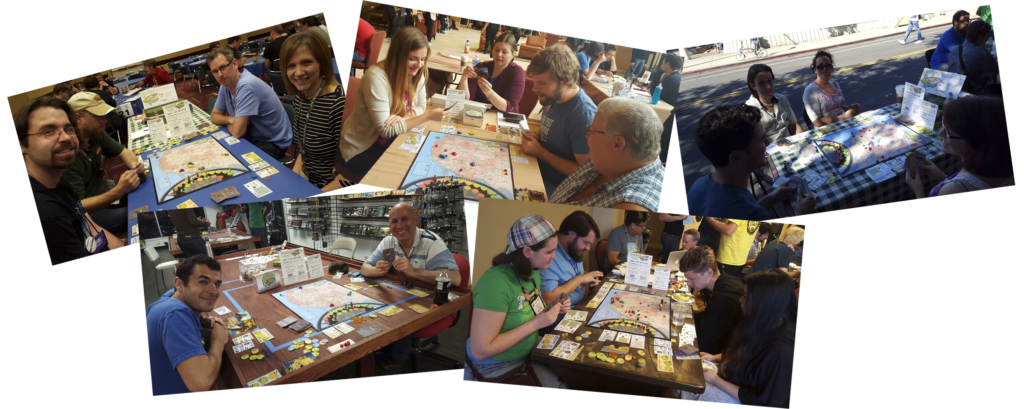Whew! It’s been quite a year – a little over a year since I decided to take Roadtrip! beyond the living rooms of my family and closest friends. I mean really, that’s the true test of a game. Most experienced game designers, as I discovered, blatantly laugh at you if you speak to them enthusiastically about your great idea that’s only ever been tested by your best fans. While the method of delivery might leave something to be desired, the message remains valid. No matter how many alpha iterations, how well you are able to visualize outcomes or run statistics, or how much you trust in the honesty of family, exposing a beta to random players is crucial. Necessarily, it’s crucial to improve game play and expose usability issues. Certainly, for new designers, it’s critical for building a network and developing a community upon whose gracious support you will thrive. However, it’s also essential to build confidence, or rather, to toughen up.

So, I took that challenge, the one the experienced designer laid before my feet. Within a week I booked tests at GenCon through First Exposure Playtest Hall. I had never before run any sort of public playtest, let alone one surrounded by complete strangers. But if I was going to make this work, I was going all in. Surprisingly, I survived. Now, 56 playtests and nine months later I’m still standing. Those playtests took place in various states, at various locations from California to New Jersey, from convention protospiels to sidewalk tables during street fairs. None were blind playtests since I was there. 28% included me (usually by necessity); 16% contained friends (because they were curious or wanted to see if they could ‘break’ it). Three went horribly wrong – so wrong I almost cried, threw up my hands and left. But the rest were incredibly helpful. Most importantly, however, I learned a few things along the way.
Playtesters are People. Even if your game is absolutely the most innovative, perfected and anticipated game of the year, know that you will have playtests where the testers behave poorly and rudely bash the game. It may be a small percentage, but it will be a percentage still. The simple fact is that everyone has bad days, so the odds are eventually a bad day will overlap with a playtest. In my first ever public playtest of Roadtrip! one person put his head down on the table and fell asleep. In another playtest, I had to request a tester not bounce and throw the game pieces. Be prepared. Don’t get defensive or discouraged. Breathe deeply. Your choice is either to end the playtest courteously or attempt to discourage the behavior civilly and refocus the group. You must, however, take some action since the disruptive behavior affects all testers at the table. Then hold your head up and remember it’ll be over soon and the odds are the next group won’t contain someone having a bad day.
Watch your Playtest. Don’t get me wrong, I’m not denying the efficacy of blind playtests. Nor am I dismissing the importance of occasionally jumping in to play with other testers, if only by necessity. What I’m saying is not to get too distracted by events surrounding the playtest. The intimacy of gameplay – reactions and interactions – is invaluable. It provides you with context for playtester commentary and with a broader understanding of player enjoyment. As to the former, do the players’ comments match their reactions in-game? Or do they contradict them? If so, why is that? As to the latter, is the game you designed doing what you intended? Are they laughing? Are they viciously competing? Is that what you want? Observation provides you with an instant point about which to engage the playtesters constructively.
Involve the Playtesters in the Solution. Don’t just ask what could be improved. Anyone can find things about which to nitpick. In fact, playtesters consider that their job. Diligently constructing a list of critiques does not really help you. Why? Because you made the game. And because you made the game, you are frequently in the worst position to grasp an innovative solution. Instead, ask the playtesters not just what the problem is, ask them how they would solve it. Let their ideas lead your imagination. Engaging testers on this level does two important things for you. First, it helps you see outside of the box. An idea you dismissed before, might actually be more plausible. Second, and, I would argue, more importantly, it enlists the testers in the design process. It gives them ownership. When they have a stake in the game’s success, they are more likely to invest their community and their money.

I’ve found that play testers automatic come with solutions, much more than they point out the problem. I use those solutions top see what part might be improved, but it hardly ever is what a play tester suggests…
Thank you, Bastiaan!
In my protospiel type tests, the testers certainly did. But in many others, the less con-like ones, I found that I had to ask them directly. Really it depended on the game experience of the playtester.
And I totally agree, frequently the solutions suggested don’t readily work (after all, they’ve only played one or two games). However, the ideas can lead both to engaging discussions (and then tester ownership) and to out-of-the-box thinking on my part.